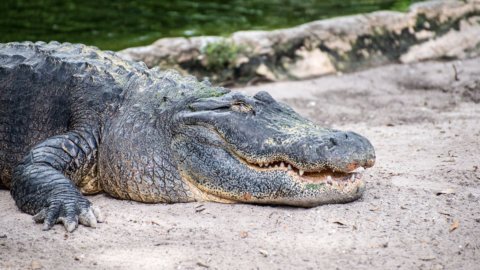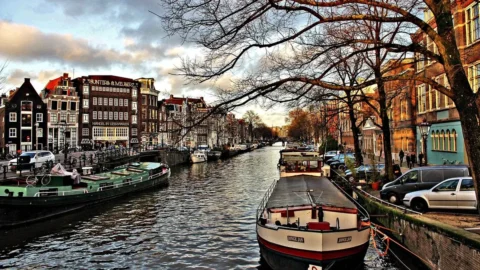Like alligators, thanks to physics, they manage to survive even the coldest temperatures…
The effects of climate change they are now there for all to see. Starting for us with this summer which is slow to arrive. A few months ago it was Florida's turn, hit by ice and snow like it hasn't been seen for years.
In addition to people, the unusual cold also caused problems for tropical animals, such as i reptiles, certainly not used to facing certain temperatures. As well as the images of the frozen iguanas, literally "rained" from the trees, the photos of thealligator stuck in the ice they went around the web (in the Italian media it was erroneously translated as "crocodile"). The images in question could make us think the worst is that the poor reptile is about to pass away. Instead, thanks to the extraordinary adaptability of these animals, this is not the case. Although accustomed to much milder temperatures, the alligator of Smap park, Ocean Isle Beach, North Carolina is not dying, but adopting what appears to be a brumation process to try to survive. Reptiles are cold-blooded living beings, they cannot generate body heat therefore they implement a sort of "energy saving" to continue to survive even in non-optimal conditions. Animals are extremely intelligent creatures and with a great survival instinct: the alligator leaves his nose out of the ice to be able to breathe while the rest of his body enters a slight hibernation in order to preserve himself until the temperatures rise again. In the specific case of the video below it is an alligator, but the same process could also be implemented by a crocodile.
While the mystery remains on how the crocodile (or alligator) does it, alas never revealed since the days of the Zecchino D'Oro, fortunately we have some more information on the brumation process. This ability of reptiles is an example of quiescence (dormancy) or a state of reversible suspension of the activities of a living organism. In nature there are many animal species capable of temporarily stopping their vital functions. This particular state of the organism can, depending on the species and the ways in which it is implemented, also be called with different forms such as torpor, hibernation (in mammals), lethargy and aestivation. It is a defense mechanism that the body puts in place following events such as: a drastic drop in temperatures, lack of oxygen, physical injuries, stress, etc. The state of activity of the organism returns to normal when the "harmful" environmental condition disappears. During the quiescent phase the animal often does not eat, drink or move. Normal vital functions such as urination and defecation are also disrupted. Both male and female reptiles go into brumation and, unlike hibernation, it is not a seasonal phenomenon, but can occur at any time of year.
In nature, brumation is determined by both external and internal factors. Herpetologists have classified these signals into two categories: endogenous, which originate within the animal, and exogenous, or influenced by external conditions. Theories related to endogenous stimuli suggest that some reptiles undergo hormonal changes, changes in neurotransmitter levels and amino acid concentrations. These factors are obviously influenced by circadian rhythms and environmental changes and this makes them a direct consequence of external environmental factors. Even today, the endogenous signals are little known even among herpetologists and it is not yet known how much they influence the state of brumation or are, instead, a direct consequence of it. THE exogenous signals include factors such as photoperiod, barometric pressure, humidity and temperature.
The phenomenon of brumation differs from hibernation in metabolic process. Unlike mammals which, during hibernation, can even go for whole months without eating or drinking, reptilians often wake up from the state of brumation to drink and immediately return to the stage of quiescence. As far as food is concerned, however, the reptile tends to eat much more before the brumation period and then almost completely refuses food as soon as the temperatures drop.
But how come the alligator decides to stay right in the frozen water to survive? Wouldn't he be less cold out of the water? Reptiles belonging to the Crocodylia family are great experts in physics, or at least, good enough for them to be able to survive. Water has a specific heatmuch higher than that of air. The specific heat of a substance is defined as the amount of heat required to raise or lower the temperature of a unit mass by 1 K. The specific heat of water corresponds to the amount of energy absorbed or released by 1 gram of water during a 1 degree Celsius increase or decrease in temperature. As can be seen from the table below, the specific heat of water is about four times greater than that of air, this means that a lot of energy is needed in water to obtain slight temperature rises.
However, thanks to the specific heat, the water absorbs the heat of the sun during the day and then gradually releases it during the night and the same happens between summer and winter. So in summary, even if water has a thermal conductivity higher than air (basically, more heat is dissipated through water than through air, as anyone who tries to wear a soaked duvet in winter well knows), the alligator puts his whole body under water because :
- The water has a high heat capacity and therefore retains the summer heat of the marsh water better than the air above it.
- The water, especially the still water in the swamp where the alligator lives, is almost still so the kinetics of heat dissipation is lower than the air, which is in constant movement due to the currents.
- The layer of ice that covers the water acts as an insulator from the cold air which in fact remains in a liquid state in the area below despite the temperature being several degrees below zero.
The combination of each of these three reasons pushes alligators, as far as we know without sophisticated scientific knowledge, to stay in the water keeping out only the minimum necessary to breathe. It seems to be precisely this ability to be able to survive even the most extreme climatic conditions practically putting the body in "stand by" which has allowed large reptiles, such as alligators and crocodiles, to survive for millions of years.
From Eniday.





